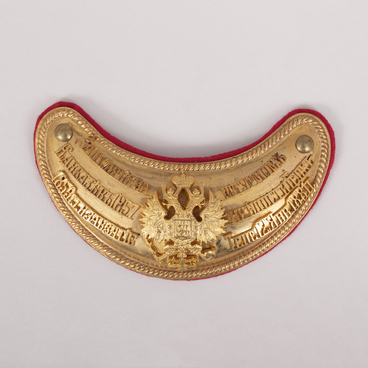The ship’s bell was an integral part of the ship. The entire life of the crew revolved around it. It was constantly watched and taken care of. The ringing of the bell announced to the crew a general gathering and sent out alerts. The bell was used as a clock, so the sailors knew when their watch started. The “Martial Chamber” displays a bell from the destroyer “Storozhevoy” (meaning “Patrol”).
The destroyer “Storozhevoy” was launched on August 11, 1906. Its speed was 26.55 knots (about 49 km/hour). The tradition of naming squadron destroyers by adjectives began in 1902. “Storozhevoy” was a destroyer of the “Deyatelny” (“Active”) type. In the autumn of 1904, the Nevsky Shipbuilding and Mechanical Plant was commissioned to build eight destroyers: “Silny” (“Strong”), “Storozhevoy” (“Patrol”), “Stroiny” (“Slender”), “Raziashchy” (“Striking”), “Rastoropny” (“Agile”), “Deyatelny” (“Active”), “Delny” (“Efficient”) and “Dostoiny” (“Worthy”).
The main difference between the new ships and the previously built destroyers was in the improved boilers of the Norman system. The Norman boilers were slightly lower in height, which made it possible to get rid of the bulky casing that cluttered the upper deck.
The ships’ artillery weapons remained standard for destroyers with a displacement of 350 tons: two 75 mm guns and six 7.62 mm machine guns. In addition, the ships could take on board 18 mines. The Coastal Defense Committee deemed “Active”-type destroyers to be able to navigate through skerries (a skerry is an archipelago consisting of small rocky islands separated by narrow straits) of the Baltic Sea due to the ships’ low draft, small size and high maneuverability.
In April 1918, “Storozhevoy” participated in the famous Ice Cruise of the Baltic Fleet. It was an operation to prevent the ships of the Baltic Fleet from being captured by German troops and to transfer them from Helsingfors (now Helsinki) to Kronstadt.
The destroyer “Storozhevoy” also took part in the
Russian Civil War — in the battles at Lankaran (a city on the shore of the
Caspian Sea) in December 1920. At the end of 1922, the destroyer was handed
over to the Baku port for storage, and three years later — to the Property
Department to be disassembled for metal.


